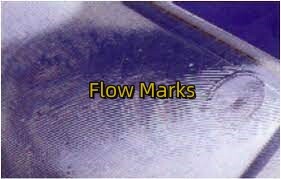Email format error
Email cannot be empty
Email already exists
6-20 characters(letters plus numbers only)
The password is inconsistent
Email format error
Email cannot be empty
Email does not exist
6-20 characters(letters plus numbers only)
The password is inconsistent

Offer Technical Support and Customized Solutions
The company is committed to creating new and improved plastic materials to meet the evolving demands of the market.

How to Prevent Flow Marks in Plastic Injection Molding
Introduction:
Flow marks, also known as flow marks, are surface defects characterized by wave-like patterns near the gate of plastic parts. These marks can detract from the overall aesthetic quality of the finished product. Understanding the causes behind flow marks and implementing appropriate solutions during the injection molding process can help prevent this issue. In this blog, we will explore the causes of flow marks and provide practical tips to eliminate them effectively.
One common cause of flow marks is inadequate mold design or construction. When the plastic melt flows from a narrow runner into a larger cavity or when the runner has a narrow and poorly finished structure, turbulence occurs, resulting in spiral flow marks on the part's surface. To address this issue, consider the following:
1.Enlarge the runner and gate section to ensure smoother flow.
2.Place the gate at thicker parts of the mold or directly on the wall to minimize turbulence.
3.Incorporate larger cold material pockets at the sprue base and runner ends to allow for more balanced filling.
Improper Process Conditions:
Inadequate process conditions can also contribute to the formation of flow marks. Factors such as low melt temperature, mold temperature, injection speed, and injection pressure all play a role. Here are some steps to optimize the process conditions:
1.Control injection speed in a graded manner, such as starting slow, increasing speed gradually, and then ending with a slower speed. This controlled approach minimizes turbulence.
2.Maintain a higher mold temperature to promote better material flow and reduce the likelihood of flow marks.
3.Adjust the barrel and nozzle temperatures within the acceptable range to ensure proper material viscosity and flowability.
Unsuitable Material for Molding Requirements:
In some cases, the choice of plastic material can contribute to flow marks. Volatile gases and plastic melts with poor flowability are more likely to cause cloudy wave-like patterns on the part's surface. To mitigate this issue, consider the following measures:
1.Opt for plastic raw materials with good stability and low viscosity whenever possible.
2.Ensure that the chosen materials meet the specific requirements for the molding process.
3.Conduct thorough material testing and analysis to identify potential issues before production.
Conclusion:
Flow marks can significantly impact the appearance and quality of plastic parts. By understanding the root causes behind flow marks and implementing appropriate solutions, such as optimizing mold design, adjusting process conditions, and selecting suitable materials, manufacturers can prevent flow marks and enhance the overall visual appeal of their products. By maintaining a meticulous approach to quality control, companies can deliver flawlessly molded parts that meet or exceed customer expectations.
Related blog:
Silver Streaks
https://www.toponew.com/blog/silver-streaks--understanding-surface-defects-in-injection-molded-parts
Short Shoot:
https://www.toponew.com/blog/how-to-deal-with-underfilled-or-short-shot-in-injection-molding

